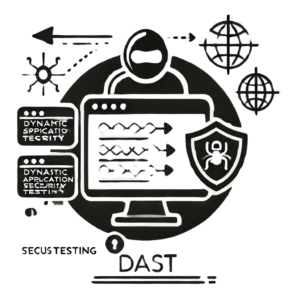Understanding Dynamic Application Security Testing

Dynamic Application Security Testing (DAST) is an important way to improve the security of your application by finding weaknesses that hackers could use to access your information. It works by scanning your application while it’s running to look for security flaws. It looks at the application from the outside, trying to find vulnerabilities by pretending to be a real attacker.
Regular DAST scans help you find and fix weaknesses in your app before bad guys can use them. This helps lower the chances of a security breach and keeps your users’ information safe.
Furthermore, it provides valuable insights into the security posture of your application, allowing you to prioritize and remediate vulnerabilities based on their severity. Implementing it as part of your security testing strategy can significantly enhance the resilience of your application against cyber threats.
Importance of DAST in Application Security
Dynamic Application Security Testing is a really important tool that helps keep your application safe from cyber attacks. It works by simulating real attacks on your application to find any weaknesses that hackers could use to break in. By running regular scans, you can find and fix these vulnerabilities before they become a real problem, making sure your app stays secure.
One of the key benefits of implementing DAST is its ability to uncover security flaws across different layers of your application, including the front end and back end. This comprehensive approach helps in identifying complex security vulnerabilities that traditional testing methods may miss. Additionally, it provides valuable insights into potential entry points for hackers, allowing you to fortify your defenses and enhance your overall security strategy. For a deeper understanding of securing your applications, consider exploring API security testing methods to further reinforce your application’s protective measures.
Dynamic Application Security Testing can help keep your important information safe from hackers. Making it a priority can lower the chances of security breaches and protect you from losing money due to cyber attacks. Make sure to use it consistently to stay prepared for potential threats.
Exploring DAST Features
Type of Vulnerabilities That Can Be Detected
Dynamic Application Security Testing is an important tool to keep your applications safe. It scans your web applications while they’re running to find different security issues that hackers could take advantage of. By testing your application from a hacker’s point of view, it can uncover security flaws that might be missed during manual checks or static analysis.
Some common weaknesses that it can find in websites include things like hackers injecting code, tricking the server into revealing sensitive information, and making unauthorized requests. These vulnerabilities are a major concern for organizations because they can be exploited by cybercriminals. DAST software helps companies identify these issues early on when websites are being built, so they can fix them before bad actors can take advantage of them.
By using DAST as part of your security plan, you can find and fix security issues in your applications before they lead to data breaches or other cyber attacks. Adding it to your security measures is essential for protecting your private information and keeping your customers and partners confident in your security practices.
Benefits and Limitations of DAST
Dynamic Application Security Testing is an important tool for making sure your application is secure. It helps by finding weaknesses in your app while simulating real cyber attacks. One great thing about it is that it shows you exactly how a hacker would try to break into your app, giving you a good idea of how secure your app really is.
Furthermore, the tools are effective in detecting common security flaws such as SQL injection, cross-site scripting, and authentication issues, helping organizations proactively mitigate risks before they can be exploited by malicious actors. By uncovering these vulnerabilities,it enables developers to address security weaknesses early in the development lifecycle, saving time and resources in the long run.
However, it’s important to acknowledge the limitations of DAST. While the tools excel in identifying vulnerabilities at the application layer, they may struggle to provide comprehensive coverage of complex web applications with dynamic content. Additionally, DAST tools may generate false positives or negatives, requiring manual verification to ensure accurate results.
DAST in Security Development Lifecycle
Incorporating DAST in SDLC
DAST is a tool that helps developers check the security of their online applications. It identifies weaknesses in the code, scripts, or settings that hackers could exploit to attack the application. By using it during development, developers can fix these problems before launching the app, making it more secure against cyber attacks.
Integrating it into the software development life cycle helps make applications more secure and saves time and money on fixing security problems after they’re already in use. It ensures that security checks are built into the development process, making applications stronger and safer. By making DAST a priority during development, organizations can prevent cyber attacks on their applications and keep their data safe.
Interplay between DAST and DevSecOps
Using Dynamic Application Security Testing is really important for making sure your apps are secure. When you add the tools to your development process, you can find and fix security problems in your web apps before they cause issues.
DevSecOps emphasizes the importance of integrating security practices early on in the software development lifecycle. DAST complements this approach by conducting automated security testing during the testing phase, allowing developers to detect and address security flaws promptly. This integration ensures that security is not treated as an afterthought but as an integral part of the development process.
Furthermore, the interplay between DAST and DevSecOps promotes collaboration between security teams and development teams. By sharing insights and findings from scans, both teams can work together to implement security controls and best practices effectively. This collaborative effort leads to enhanced application security, reduced vulnerabilities, and improved overall resilience against cyber threats.
Comparing with Other Testing Methods
DAST vs SAST
When it comes to keeping your applications secure, it’s important to know the difference between two types of testing: Dynamic Application Security Testing and Static Application Security Testing (SAST).
DAST looks for vulnerabilities while the application is running, simulating how attackers might try to exploit them. This gives a well-rounded view of the application’s security.
On the other hand, SAST analyzes the application’s source code without running it. This helps find potential security issues in the code early on, so developers can fix them before the application is used.
While both DAST and SAST play important roles in application security, they each have their strengths and weaknesses. DAST is effective in identifying vulnerabilities related to the application’s configuration and runtime behavior, while SAST excels in uncovering flaws in the code that could lead to security breaches. Combining both testing methods in a comprehensive security testing strategy can help ensure that your applications are robustly protected against potential cyber threats.
DAST vs IAST
When it comes to ensuring the security of your applications, employing the right testing methodologies is crucial. Dynamic Application Security Testing and Interactive Application Security Testing (IAST) are two popular approaches that help organizations strengthen their application security. DAST involves analyzing a running application for security vulnerabilities by sending various malicious inputs and observing the outputs, making it an external testing method. On the other hand, IAST is an internal testing method that leverages instrumentation within the application to provide real-time security feedback as the application is running. While DAST is effective in detecting known vulnerabilities through black-box testing, IAST offers deeper visibility into the application’s inner workings and the ability to identify vulnerabilities in real-time. By integrating both DAST and IAST into your security testing strategy, you can achieve a comprehensive approach to securing your applications and minimize the risk of potential cyber threats.
Choosing the Right Security Testing Tools
Dynamic Application Security Testing is essential to ensure that your applications are secure by identifying vulnerabilities that hackers could exploit. When selecting security testing tools for your organization, it’s crucial to consider various factors to ensure they align with your requirements. For a comprehensive understanding of how to effectively implement security measures, you might want to explore more about application security testing.
When selecting a security testing tool, make sure it works well with the size and complexity of your app. Think about how easy it is to use with your current development and testing processes. Look for tools that give you clear reports to help you handle and fix any security issues.
Furthermore, assess the level of automation offered by the security testing tools to optimize efficiency and reduce manual efforts. Look for tools that support continuous testing and integration within your DevSecOps pipeline for seamless security testing throughout the development lifecycle. By carefully selecting the right security testing tools, you can enhance the resilience of your applications against cyber threats and ensure robust application security.
Future Outlook on DAST
In today’s world of cybersecurity, Dynamic Application Security Testing is essential for keeping our applications secure. As technology improves, cybercriminals are also getting better at finding ways to hack into systems. The future of it looks bright, with ongoing improvements to make security testing even more effective.
In the future, it is improving by using machine learning and artificial intelligence in testing tools. This helps to find and fix security weaknesses more effectively, so companies can prevent cyber attacks before they happen.
Furthermore, the shift towards DevSecOps practices will drive the adoption of DAST within the software development lifecycle. By incorporating security testing in the early stages of development, organizations can build more secure applications and minimize the risk of potential breaches.
Overall, the future of DAST looks bright, with a focus on leveraging technology advancements and best practices to strengthen application security and mitigate risks effectively.
